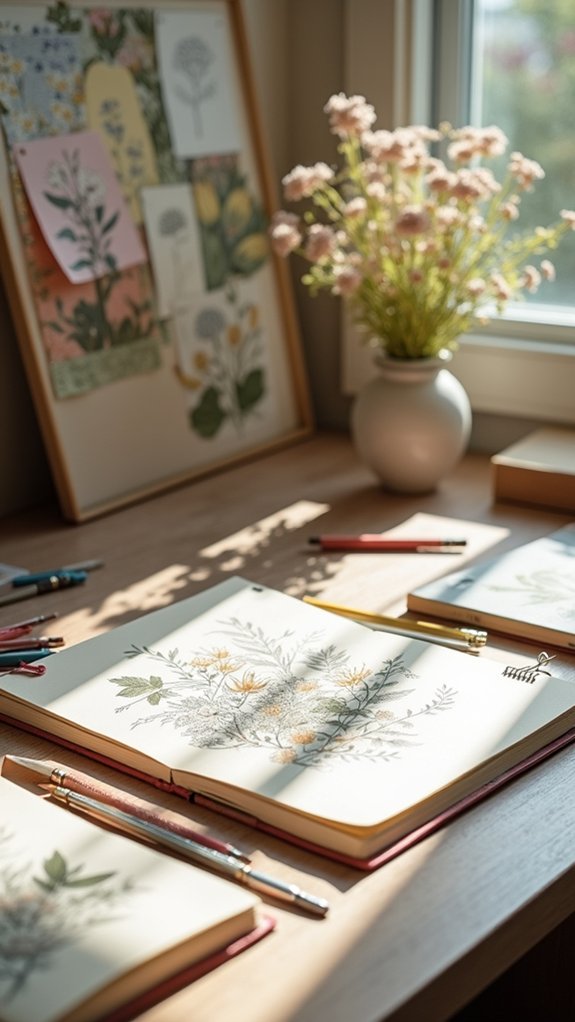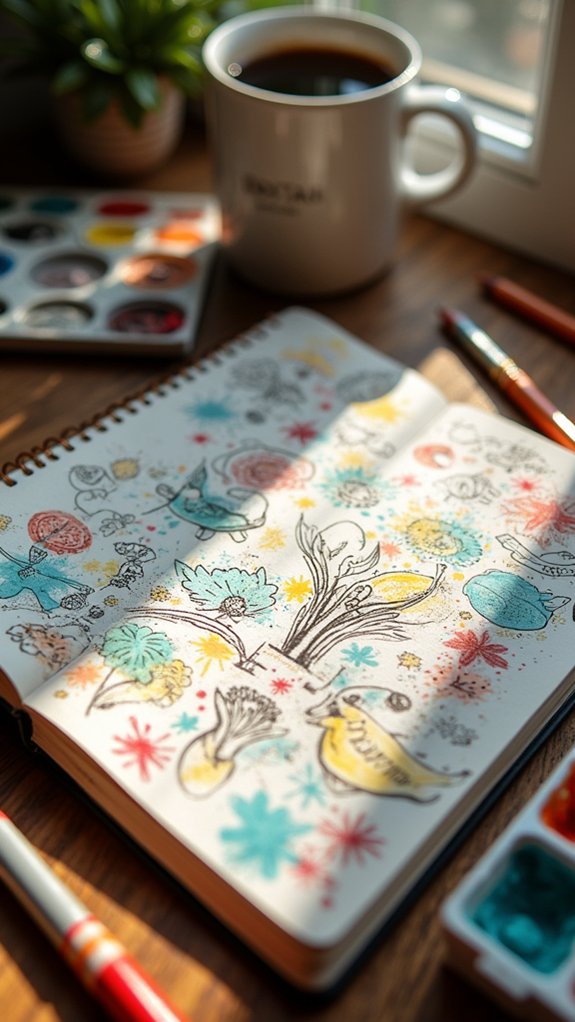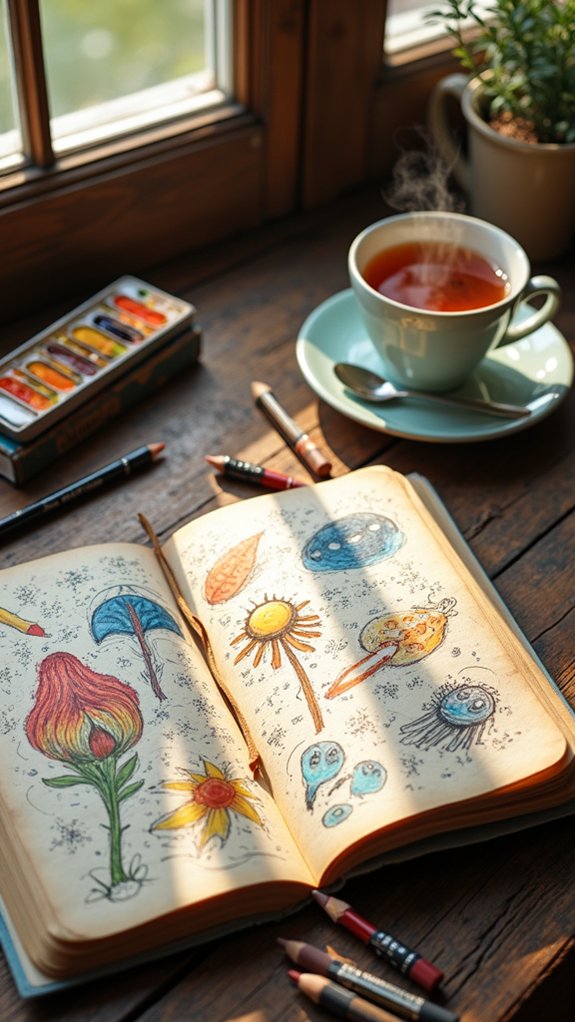Keeping a sketchbook journal that inspires is all about picking sturdy paper, gathering some fun supplies, and not being afraid to get a little messy. Choose a theme—a color, a favorite place, even your cat’s grumpy face—and use both pictures and words to capture your thoughts. Stuff in odd things like ticket stubs or candy wrappers for extra personality. The best part? Mess-ups just make it more interesting. There’s a ton more you can try with your sketchbook, too.
Key Takeaways
- Choose a durable, inspiring sketchbook and versatile art supplies that encourage regular use.
- Set meaningful themes for your pages to guide creativity and maintain motivation.
- Blend words with sketches, such as quotes or personal reflections, to add depth and personal meaning.
- Embrace imperfection and experiment with mixed media for playful, pressure-free exploration.
- Collect and attach mementos or everyday items to capture memories and spark new ideas.
Choosing the Perfect Sketchbook and Supplies
Even though picking out a sketchbook sounds simple, it’s actually a big deal—sort of like choosing a sidekick for every creative adventure.
The right sketchbook is sturdy, with paper weighing more than 70 lbs, so it survives wild ideas—no rip, no weird see-through disasters. Size matters, too! A “Goldilocks sketchbook”—not too huge, not too tiny—fits backpacks and lets creativity sneak in anywhere, anytime.
Upcycling an old book is a cool move, adding history and some mystery. When building an art supplies kit, throw in pencils, ink pens, maybe watercolors, so creative inspiration never hits a dead end.
Most importantly, pick a sketchbook you can keep coming back to, adding new sketches or finishing half-scribbled masterpieces whenever the mood strikes.
Setting a Theme for Your Pages

With a trusty sketchbook and a pocketful of wild art supplies, the next big question pops up: what should actually go on those pages? One super-helpful trick is picking a theme for your pages.
Themes help the creative process feel less scattered and more focused—it’s like giving your sketchbook a secret mission. Think: favorite places, wild animals, or even just the color blue.
Before getting lost in color, sketch a pencil draft first to nail down your theme. There’s no rush! Adding to your pages little by little, you can explore your theme and personal expression at your own pace.
It’s totally fine to drop a theme for a bit, then return with fresh eyes. Who knows what new brilliance will appear?
Blending Words and Art for Deeper Reflection
Crack open any sketchbook journal and there’s a good chance it’s not just pictures crowding the pages—words sneak in, too, filling up the empty corners and blank spaces.
That’s the magic of blending words and art: it isn’t just about making things look cool, it’s about mixing visual inspiration with emotions and thoughts that sometimes can’t be drawn.
Adding quotes, quick lines of poetry, or even your weirdest daydreams next to doodles gives each page a double dose of meaning.
Sometimes, scribbling a memory next to a sketch makes that moment hit even harder when you flip back through.
Plus, if you ever hit a creative block, switching between writing and drawing can spark fresh ideas, leading to deeper reflection and new discoveries.
Embracing Imperfection and Creative Exploration

Imperfection can be a secret weapon in a sketchbook journal, turning what might look like mistakes into unexpected masterpieces. By embracing imperfection, artists let go of the scary idea that everything has to be “just right.”
Creative exploration takes over, allowing doodles, splatters, or uneven lines to become part of the story. Sometimes, that “oops” is actually the most exciting part of the page!
Experimenting with mixed media—like watercolor, markers, or even scraps of paper—makes the process feel more like play than stress. In a sketchbook journal, nobody’s grading you, so every squiggle can spark curiosity and lead to growth.
Each page is a fresh start, a chance to grow, laugh at mistakes, and truly enjoy making art.
Collecting and Preserving Memories in Your Journal
A sketchbook journal isn’t just for drawing; it’s also the perfect spot to stash little treasures like movie tickets or candy wrappers from a great day out.
Adding these quirky mementos turns each page into a snapshot of real life, mixing quick doodles with bits and pieces that make memories stick.
When you capture a sunset or a snack wrapper, you’re not just saving paper—you’re saving the feeling behind it too, and that’s what makes your journal so special.
Capturing Everyday Moments Creatively
Even though life can seem ordinary, sketchbook journaling turns the little moments—like messy lunches or rainy bus stops—into something you actually want to remember.
When someone keeps a daily art journal, it’s not just about drawing perfectly; it’s about spotting cool details in the everyday, like how the light hits your sneakers or the pattern of raindrops on a window.
The benefits of keeping these sketches are huge: it helps people focus, calm down, and even feel happier.
Adding quick notes or little stories next to the drawings can make the memories pop and really tell the story behind them.
Trying out colored pencils or watercolors adds even more fun, and going back to add stuff later keeps things exciting and spontaneous.
Incorporating Meaningful Ephemera
While some people might think a sketchbook journal is just for drawings, that’s only half the story—there’s something truly magical about adding little treasures from real life, too.
Ephemera like crumpled ticket stubs, colorful business cards, or postcards can transform any sketchbook into a vault of memories. These bits and pieces do more than just decorate a page—they add context, create stories, and even bring back forgotten adventures (who knew a receipt could be a time machine?).
Try these fun ways to weave ephemera into your journal:
- Attach pockets or envelopes to stash secret notes and memorabilia.
- Organize items by trip, mood, or theme to spark new ideas.
- Use adhesive corners for easy adding and swapping of your favorite scraps.
Your memories, your rules!
Building a Consistent and Enjoyable Practice

Jumping into a sketchbook journal can feel a bit like starting a new adventure—exciting but also a little wild. That’s why building a routine is super helpful.
Setting aside time each week to draw, doodle, or jot things down makes the practice consistent, turning it into something you actually look forward to—like a secret mission for your creativity.
Picking a sketchbook that feels good in your hands, with sturdy paper over 70 lbs, lets you try out all kinds of pens without worrying about pages getting wrecked.
Don’t rush! Add to your pages whenever inspiration strikes—slow and steady wins the art race.
Most importantly, treat your sketchbook as a safe space. Forget perfection. Scribble, paint, or paste whatever you want, judgment-free.
Finding Inspiration and Community in Sketchbook Journaling

How do artists keep their creative fire burning when they’re staring at a blank page? Sometimes, all it takes is finding the right spark!
Engaging with a community can totally change the game in sketchbook journaling. Meeting other people who love to draw or paint in their sketchbook can help anyone feel less stuck and more inspired. It’s like having a team cheering them on, offering feedback, and sharing new ideas that just might lead to their next cool page.
Plus, there are tons of ways to find that inspiration boost:
- Join online challenges or prompts—Instagram and forums are full of them!
- Share sketchbook pages on social media for encouragement and tips.
- Attend local art groups, workshops, or meet-ups for fun and fresh perspectives.
Frequently Asked Questions
Can You Use a Sketchbook as a Journal?
A sketchbook can indeed function as a journal, utilizing sketchbook prompts for reflection, fostering artistic expression, and enabling visual storytelling. This approach merges art and narrative, allowing individuals to document experiences and emotions beyond traditional written journaling.
How to Keep a Creativity Journal?
Keeping a creativity journal involves utilizing creative prompts, engaging in daily reflections, and practicing visual storytelling. Integrating different media and setting aside regular time encourages exploration, helping individuals develop inspiration, fresh perspectives, and sustained creative growth over time.
What Makes a Sketchbook Successful?
A successful sketchbook combines visual consistency with opportunities for thematic exploration and material experimentation. It allows artists to freely experiment with new ideas while maintaining a recognizable visual narrative, fostering both creative development and personal engagement throughout the process.
How to Start a Sketchbook Diary?
To start a sketchbook diary, one might select visual prompts or daily themes to spark creativity. Incorporating mixed media enhances exploration, while a flexible, pressure-free approach encourages consistent engagement and allows for evolving expression over time.
Conclusion
A sketchbook journal can be like a magic door to creativity, memories, and even a few happy messes. With the right supplies, a fun theme, and a dash of bravery, anyone can make pages that truly inspire. Words and drawings work together like peanut butter and jelly—way better together. And hey, who cares about perfection? Just have fun, explore, and let your personality shine through. That’s what makes a sketchbook journal truly awesome.


Leave a Reply